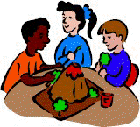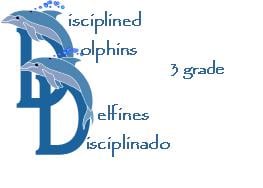Media Center → Third Grade Learning Zone
Third Grade Learning Zone -
Click here to see the 3rd Grade Vision.
| Math |  |
| Reading | |
| Science | |
| Social Studies | |
Math
Math Games
- Weekly Brain Teasers- Choose your grade level for weekly challenges; solutions are posted the following week, with archives of past puzzles. Students can submit answers directly.
- Elementary Math Problem of the Week- Printable problems for elementary math classes; you can submit your class answers online or wait for the solutions.
- Harcourt Brace E-labs
The interactive activities on these pages go directly with our math textbook. See your teacher for specific directions for the activity you are working on. - Multimedia Math Glossary from Harcourt Brace
Wondering what that word on your homework means? Unsure of a concept? This multimedia dictionary will help you understand the vocabulary you need to be successful in math. - AAA Math
Hundreds of pages that review basic math facts and concepts. Each page includes a short "lesson", interactive problems, and challenge games. Choose topics by grade level or from a list of specific math topics. This is a great site for review as well as practice. - A plus Math
Click on the "Game Room" to play interactive games like concentration while practicing basic math facts. Or,use the interactive flashcards instead. - KS2 Bitesize from the BBC
Loads of math games and quizzes from the BBC Maths site. - Math Magic Challenges- Archives of Math Magic Challenges by grade level.
- Interactive Math Website- Impressive content and features are well organized and useful for both teachers and students.
- FunBrain Games-Test your skills at different levels. A great mind exercise.
- Math Mania- Clink on a book to see student-generated questions and book summaries!
- Mathematics Lessons that are Fun! Fun! Fun!- Advanced activities for Grades 3 -5.
Reading
Reading is Fun!
- Online Children's Stories-Stories available on the Internet to read.
- Children's Literature Authors and Illustrators- Web sites links to authors and illustrators.
- 700+ Great Sites- Amazing, Spectacular, Mysterious, Wonderful Web Sites for Kids.
- Cool Sites for Kids- READING AND WRITING, FACTS AND LEARNING, and JUST FOR FUN!
Science
The Solar System - Solar System Web Sites (via Ms. Carper)
- Star Child: A Learning Center for Young Astronomers
- NASA Kids
- Astronomy for Kids
- Amazing Space
- Enchanted Learning-Zoom Astronomy
- Windows to the Universe
Crime Lab Chemistry
Crime Lab Chemistry: Children assume the role of crime lab chemists and solve a crime using paper chromatography techniques. They explore similarities and variations of fingerprints and use a classification system to solve a crime. This unit combines two GEMS (Great Explorations in Math and Science), publications, Crime Lab Chemistry and Fingerprinting. They were developed by the Lawrence Hall of Science, University of California, Berkeley.
- You Can - FingernailsThough not specifically about fingerprints, this page gives an explanation of how fingernails form, including an interesting cross-sectional schematic diagram.
- Chromatography:You Can & PaintAnswering the question, "How do you make paint?" Beakman and Jax describe the process of mixing pigment with a vehicle, the substance in which the pigment is carried.They supply directions for two methods of making paint using a brick or colored chalk as pigments.
- Why do Leaves Change Color?This web site is maintained by the "Curious Kids Science Newsletter." Directions are provided for parents and children to work together to separate the pigment colors in a leaf using rubbing alcohol, filter paper, hot water, and a leaf. Subscription information is provided.
Sounds
Sounds: Children investigate characteristics of sound. They explore ways that sounds are produced, received, and used in everyday life. Emphasis is placed on developing questions, seeking answers through investigations, recording data, and communicating results. Sounds was developed by the National Science Resources Center with support from the National Academy of Sciences and the Smithsonian Institution.
- You Can- My Own Voice"Why does my voice sound different on a tape recorder?" is answered by Beakman and Jax in a style easily understood by children. Clear, simple schematic diagrams of the outer and inner ear are included. A sound activity for children requiring a fork and a string is included with the explanation.
- You Can - Car HornsThis page answers the question, "How come a car horn sounds low when it's far away and high-pitched when it's closer?" It explains the Doppler Effect simply, using a schem atic diagram as an aid. Students can hear a wonderful example of the Doppler Effect by clicking on the cue. Directions for an activity where students can create their own Dopper Effect are clearly described.
- You Can & ThunderThis web site answers the question, "What is thunder made out of?" Beakman and Jax describe how a tremendous push of sound waves from the explosion of lightning results in a loud boom. Several science activities are suggested which illustrate this point.
- Pathfinder: Musical Invention Convention
Plant Growth and Development
Plant Growth and Development: Children plant and observe the growth of Brassica rapa. Records of growth are kept and used to construct charts and graphs. The students pollinate the flowers with dead bees and harvest seeds. Plant Growth and Development was developed by the National Science Resources Center with support from the National Academy of Sciences and the Smithsonian Institution.
- Scanning Electron Microscope - Image GallerySee scanning electron microscope images of various plant parts and insect parts. This close, some images might be unrecognizable to children, but this technolog y gives them a new perspective on visual observation.
- Dandelion - Science Museum of MinnesotaThis site describes how dandelion seeds travel in the wind, and shows several high quality photographs of dandelion seeds and seed heads.
- Dandelion Internet Links- Science Museum of MinnesotaThis is a launch point from the Science Museum of Minnesota to the Texas A&M University Department of Biology Herbarium. They have a large image collection that includes three images of dandelions.
- TreesThis web site is posted by "Dragonfly," a children's science magazine published by the National Science Teachers Association. Each issue has a different theme. This "Trees" web site focuses on commonly asked questions about trees' structure, function, and interaction with their ecosystem. Their are excellent links to expository information about specific types of trees, seed dispersal,survival mechanisms, and other information. Directions are given for several tree-related experiments stud ents can try at home.
- Wisconsin Fast Plants Home PageMaintained by the University of Wisconsin, where fast plants were developed, this web page is an excellent companion to the 3rd grade Plant Growth and Development Unit.It provides a wealth of information about Brassica plants, a list of frequently asked questions, and an e-mail address so you can contact the researchers at the University of Wisconsin directly. There are even instructions for joining an electronic discussion group about fast plants. Don't miss the section titled "Around the World With Brassicas, " an excellent captioned slide show of various types of Brassica plants grown around the world.
Biomes
Rainforest Links
- Student Lesson Amazon: Welcome to the Amazon! Today you are going to research the Amazon.
- Tropical Rainforest
- Journey Into Amazonia
- Live from the RAINFOREST
- ZOOM RAINFORESTS
- Rain Forest Adventure
- Take A Walk In The Rainforest A PBS sponsored virtual tour.
- Amazon Interactive
- Amazon Rainforest Web Lesson
Animal Links
- PATHFINDER - Start Here
- Pathfinder Exploring the Tundra - Natural Regions of the World
- Lesson Plan
- Zoo Net
- Electronic Zoo
Biomes Links
- Biomes at the Missouri Botanical Gardens An outstanding site that describes the natural regions of the world. Do not be alarmed by the use of science terminology. The following are kid-friendly descriptions of the natural regions of the world (biomes):
- Grasslands
- Taiga
- Tundra
- Desert
- Temperate Deciduous Forest
- Temperate Forest Biome Resource Tour
- Explore the Fantastic ForestAn interactive site by National Geographic that allows students to explore what's in a forest.
- Desert Field Trip
- Biomes of the World A professor's description of the natural regions of the world, aslo known as biomes.
- The World's Biomes Teacher friendly descriptions of tundra, desert, grasslands, and forests.
Social Studies
More Links coming soon!

